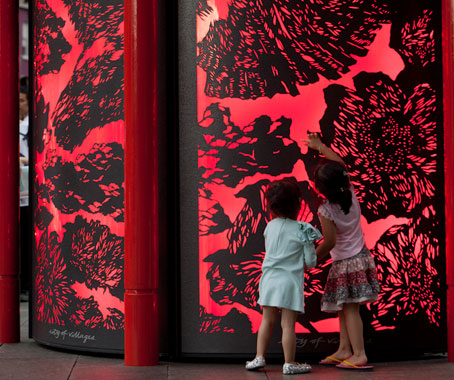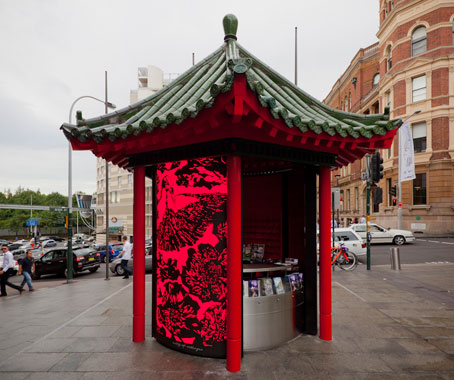Frost’s award-winning young gun graphic designer Katie Bevin has recently returned from a stint in Washington DC, judging this year’s entries to the Society of Environmental Graphic Design 2012 Awards.
April 2nd, 2012
One of Frost* Design’s newest recruits, Katie Bevin, recently returned from Washington DC, where she took part in the judging panel for this year’s Society of Environmental Graphic Design (SEGD) 2012 Global Design Awards.
Bevin joined 7 other jurors in sifting through 3000 entries to the annual awards program, which for nearly 15 years has recognised some of the best, most innovative projects in the field of environmental graphic design.
This year’s impressive entries, Bevin says, were “really slick, really digital; things like projection. A lot of the work was very integrated with the environment. Environmental design is very multidisciplinary – environment, landscape, interior, industrial design all combine to create this [work]. You could see they really joined all of those disciplines together.”
Bevin knows her stuff, having received an Honour Award at the 2011 SEGD Awards for her Urban Tales shadow typography, a concept she created while still a student at Auckland’s Massey University.
The site-specific time-based installation (pictured above) incorporated 8 bollards and incomplete typography that worked with light and shadow to gradually form letters and words as the day progressed and the sun travelled through the sky, ultimately spelling out the phrase ’from here to there and there to here.’
Simple, clever and visually effective, the project garnered much praise from the 2011 award jury and led to her being selected to judge the 2012 awards – no small feat for a designer who “stumbled into” the field of environmental graphics.
“I studied graphic design at university,” she explains. “A lot of projects in my last year started branching out into 3-dimensional work. Without really thinking, my work started getting out of print and [I began] making these huge, large-scale things… I love thinking big.”
Now a junior designer at Frost* design studio in Sydney, Bevin is taking part in a whole range of new work.

“At the moment I’ve been working very heavily on UTS, which is a really exciting project,” she says.
The Frost* team is in the midst of creating a signage and wayfinding strategy for the expanded University of Technology Sydney, which will soon see two new buildings – including the much-discussed Gehry-designed Dr Chau Chak Wing Building – integrated into the campus’ environment.
To be a good designer in environmental graphics, Bevin says, “you have to be able to think spatially, because it’s very 3-dimensional; you have to think about how people are going to experience those spaces.
“The projects we get through Frost* are awesome; we can think really big, and we can do really crazy stuff that hasn’t been done before.”

Frost* Chinatown Kiosk project for City of Sydney
Frost* Design
frostdesign.com.au
Society for Environmental Graphic Design
segd.org
A searchable and comprehensive guide for specifying leading products and their suppliers
Keep up to date with the latest and greatest from our industry BFF's!

The Sub-Zero Wolf showrooms in Sydney and Melbourne provide a creative experience unlike any other. Now showcasing all-new product ranges, the showrooms present a unique perspective on the future of kitchens, homes and lifestyles.

Suitable for applications ranging from schools and retail outlets to computer rooms and X-ray suites, Palettone comes in two varieties and a choice of more than fifty colours.

Sub-Zero and Wolf’s prestigious Kitchen Design Contest (KDC) has celebrated the very best in kitchen innovation and aesthetics for three decades now. Recognising premier kitchen design professionals from around the globe, the KDC facilitates innovation, style and functionality that pushes boundaries.

Savage Design’s approach to understanding the relationship between design concepts and user experience, particularly with metalwork, transcends traditional boundaries, blending timeless craftsmanship with digital innovation to create enduring elegance in objects, furnishings, and door furniture.
Metroweave draw on special expertise and a wide network of contacts to deliver the finest fabrics available.

DKO’s Interior Design Director on how to create community and specificity in interior design, and how apartment living is being reconceptualised.
The internet never sleeps! Here's the stuff you might have missed

Welcome to the year of the Design Effect. This year’s theme aims to showcase the profound ripple effects that exceptional design can have on people, place and planet. Join in shaping this narrative by contributing your perspective before May 3, 2024, and become a part of the Design Effect movement.

Swiss home appliance designer and manufacturer V-ZUG’s first Sydney studio is a unified expression of the brand’s boutique, sustainable and design-led identity.